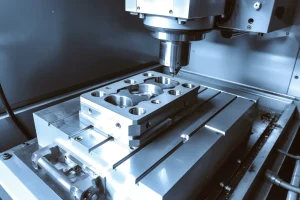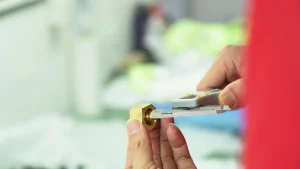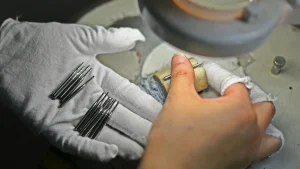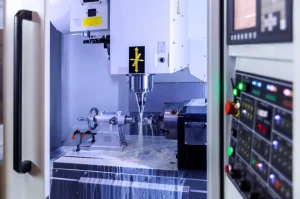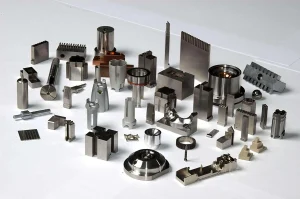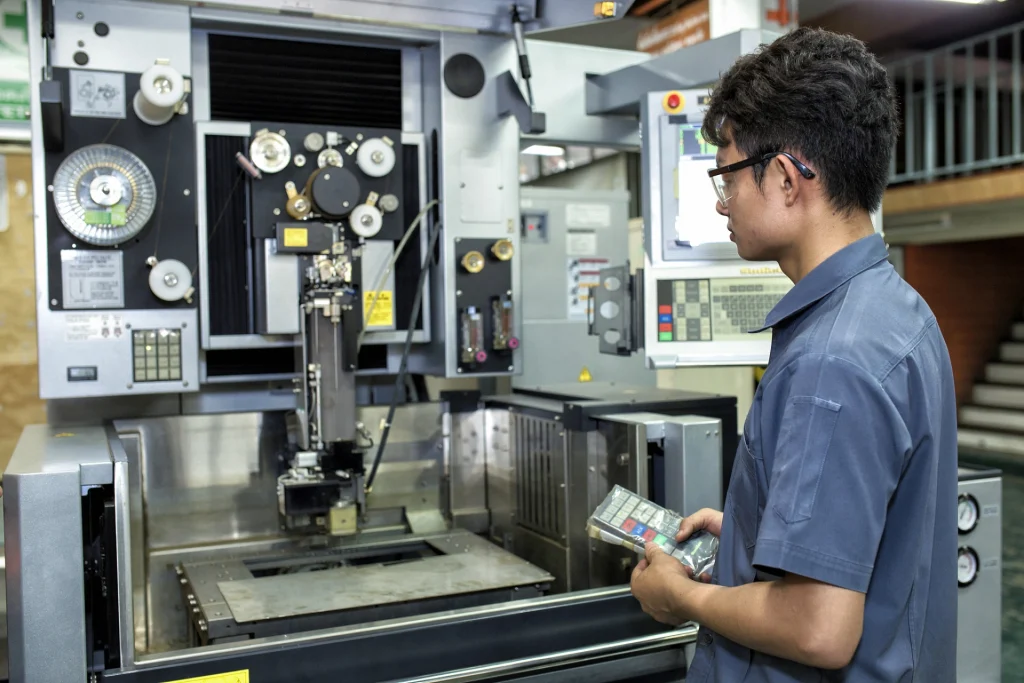
The standard process of CNC machining is generally 7 steps, and each process is required to be carried out in sequence. If it is not carried out in the order of the standard process of the CNC machining center, it is easy to cause machine failure or personal safety. The staff needs to pay special attention.
1. CNC machining start-up preparation
After each power-on or emergency stop reset of the machine, the machine will return to the machine reference zero position (i.e. zeroing), so that the machine has a reference position for subsequent operations.
2. CNC machining workpiece clamping
Before cleaning the surface of the workpiece, it should be cleaned first, and it should not be stained with oil, iron, or dust, and the surface burrs should be removed with a file (or oilstone). The surface of the fixture must be polished to make it flat and smooth. The iron and nut must be firm and can reliably clamp the workpiece. For some small workpieces that are difficult to install, they can be clamped directly on the tiger head; the machine table should be clean, free of iron filings, dust, and oil; at the four corners of the workpiece, the middle workpiece is too large and needs to add a high angle in the middle. According to the drawing size, use a ruler to check whether the length and width of the workpiece are qualified.
When clamping the workpiece, follow the programming instructions to install it to avoid the possibility of encountering the fixture in the processing part and the processing head. After the workpiece is placed on the horn, the workpiece reference surface needs to be pulled out according to the drawing requirements. For workpieces that have been processed on both sides, check whether the verticality is qualified. The nut must be tightened after the workpiece is pulled to prevent the clamp from being loose and the workpiece from being displaced during processing; then pull the table once, and the error is not good after confirming the error. It is necessary to check whether the verticality is qualified.
The nut must be tightened after the workpiece is pulled to prevent the clamp from being loose and the workpiece from being displaced during processing; then pull the table once, and the error is not good after confirming the error. It is necessary to check whether the verticality is qualified. The nut must be tightened after the workpiece is pulled to prevent the clamp from being loose and the workpiece from being displaced during processing; then pull the table once, and the error is not good after confirming the error.
3. Number of contacts of CNC processing workpieces
The reference zero can be processed by the number of contact heads for clamping the workpiece, and the contact heads can be photoelectric and mechanical. There are two types of touch methods: single-sided touch and single-sided touch. The steps of split touch are as follows: photoelectric static, mechanical speed 450~600rpm. Manually move the X axis of the worktable in the middle of the touch, so that the touch head touches one side of the workpiece. When the touch head just touches the workpiece and the red light is on, set the relative coordinate of the point to zero; the X axis touches the other side of the workpiece, and the relative coordinate of the moment the touch head touches the workpiece. According to its relative value, subtract the head diameter (that is, the length of the workpiece), and divide the relative coordinate number by 2. This value is the middle value of the workpiece X axis. Then move the worktable to the middle value of the X axis, and set the relative coordinate value of the X axis to zero, which is the workpiece zero point on the X axis. Use one of G54~G59 to carefully record the mechanical coordinates of the zero position on the workpiece X axis, and let the machine tool determine the zero position on the workpiece X axis. Check the correctness of the data again. The zero setting of the workpiece Y axis is the same as that of the X axis.
4. CNC machining preparation tools
According to the tool data in the programming operation guide, replace the tool to be processed, let the tool hit the height gauge on the reference surface, and set the relative coordinate value to zero when the measuring light is on. Move the tool to a safe position, manually move the tool down 50mm, and reset the relative coordinate value to zero. This is the zero point of the Z axis.
The mechanical Z value of this point is recorded in one of G54 to G59. This completes the zeroing of the workpiece X, Y, and Z axes. Check the correctness of the data again. The touch method on the other side is also to touch one side of the workpiece X and Y axes. The point of the X and Y axes relative to the head radius coordinate value is the zero point of the X and Y axes, and the mechanical coordinates of the X and Y axes are recorded in one of G54 to G59. Check the correctness of the data again. Check the correctness of the zero point and move the X and Y axes to one side of the workpiece. Check the correctness of the zero point according to the size of the workpiece. Copy the program file to your computer according to the file path in the programming guide.
5. CNC machining parameter setting
Machining spindle speed setting: N=1000×V/(3.14×D)
N: spindle speed (rpm/min)
V: cutting speed (m/min)
D: tool diameter (mm)
Machining feed speed setting: F=N×M×Fn
F: feed rate (mm/min)
M: number of blades
Fn: tool cutting amount (mm/rev)
Cutting amount per blade setting: Fn=Z×Fz
Z: number of blades
Fz: cutting amount per cutting blade (mm/rev)
6. Prepare for CNC machining
At the beginning of each program, you must carefully check whether the tool you are using is written for the tool specified in the instruction manual. Start CNC machining feed, feed speed to the minimum, single-stage execution, fast positioning, feed, feed must be concentrated, hand should be placed on the stop button, stop immediately if there is a problem, observe the direction of tool movement, ensure safety knife, and then slowly increase the feed speed to a suitable level, while the tool and workpiece are cooled with coolant or cold air. CNC rough processing cannot be too far away from the control panel. If there is any abnormal phenomenon, stop the machine for inspection in time.
Open and pull the workbench again to confirm that the workpiece is not loose. If so, you must recalibrate and touch the number. In the process of continuously optimizing CNC processing parameters, the best CNC processing effect is obtained. Because the process is a key process, after the workpiece CNC processing is completed, the main dimensions of the drawing should be measured to see if they are consistent with the drawing. If there is a problem, immediately notify the team leader or programmer to check. After solving it, it must be self-tested and sent to the inspector for special inspection.
Hole processing: The center of the hole in the CNC processing center must be positioned with a center drill first, then drilled with a drill bit 0.5 to 2 mm smaller than the drawing size, and finally CNC fine processing with a suitable drill bit.
Reaming process: The reaming of the workpiece is also first positioned with a center drill, then drilled with a drill bit 0.5 to 0.3 mm smaller than the drawing size, and finally reamed with a reamer. The spindle speed is controlled at 70 to 180 rpm during the reaming process.
Boring processing: The workpiece is first positioned with a center drill, then drilled with a drill bit that is 1 to 2 mm smaller than the drawing size, and then processed with a rough boring tool (or milling cutter) to only 0.3 mm on one side and a suitable processing allowance, and finally fine boring with the pre-adjusted fine boring tool size. The final fine boring allowance cannot be less than 0.1 mm. Direct CNC (DNC) operation: Clamp the workpiece, set zero, and set parameters before DNC numerical control processing. Open the number of processing programs on the computer for inspection, then let the computer enter the DNC state, and enter the correct processing program file name. Press the TAPE key and the program start key on the machine, and the machine controller will flash the word LSK.
7. Self-inspection of CNC processing workers
The processor must read the content of the process card before CNC processing, understand the parts, shape and drawings of the workpiece, and then know the size of the process. Before clamping the workpiece, the blank size should be measured to see if it meets the requirements of the drawing. When the installation and programming instructions are consistent with the instructions, the workpiece must be carefully checked. After the rough processing is completed, self-inspection should be carried out in time to adjust the data error in time. The size of the self-test content is mainly the size of the processing site. Such as: whether the workpiece is loose; whether the workpiece is correctly divided; the size of the CNC processed parts to the reference edge (reference point) is consistent with the drawing requirements; the position size between the processed parts.
After the self-test is completed. After the CNC processing is completed, the worker should handle the shape and size of the processed parts. Self-test: the vertical surface of the CNC processing site detects the basic length and width dimensions, and the slope dimensions marked on the processing site are measured. The basic dimensions. After the worker completes the self-test of the workpiece and confirms that the workpiece is consistent with the drawings and process requirements, the inspection personnel will conduct a special inspection.

